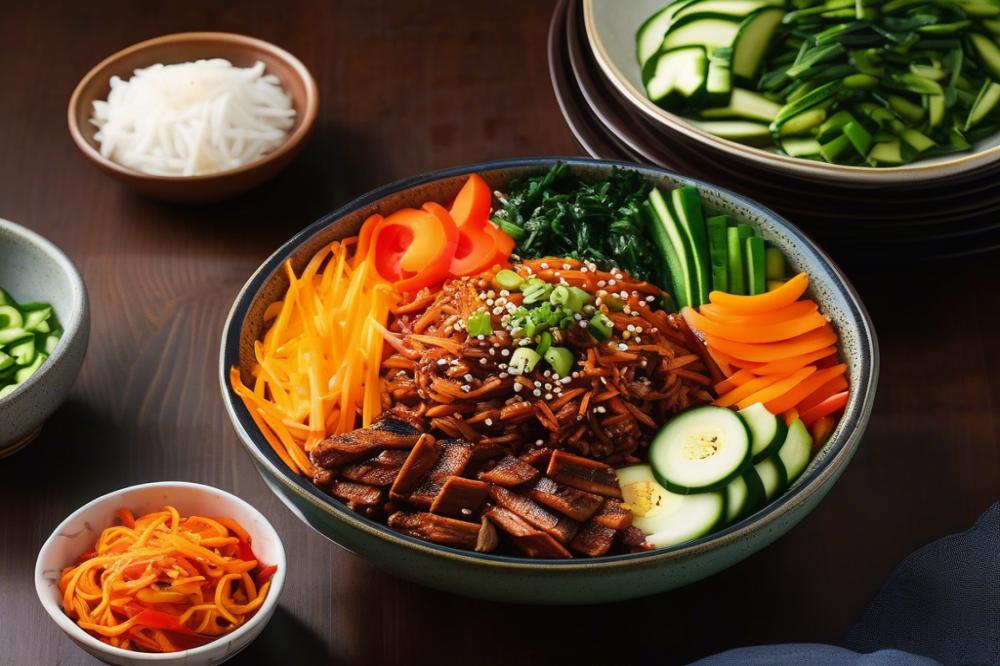Introduction
Gochujang Bibimbap is a vibrant and flavorful dish that perfectly represents the essence of Korean cuisine. This traditional rice bowl combines a variety of ingredients, making it both attractive and nutritious. A bibimbap recipe often includes colorful vegetables, a fried egg, and a dollop of gochujang sauce, which adds a distinctive spicy kick.
The importance of this dish in Korea cannot be overstated. Bibimbap not only reflects local ingredients but also showcases the country’s culinary traditions. It is served in many households and restaurants, making it a staple that many people enjoy. With its mix of flavors and textures, it appeals to a wide range of tastes.
For those seeking healthy meals, Vegetable Bibimbap stands out as an excellent vegetarian option. Packed with an array of fresh vegetables, it offers a delightful crunch alongside soft rice. Eating this dish allows for a balance of nutrients while still enjoying the bold flavors of spicy Korean food. Quick recipes like this one fit seamlessly into busy lifestyles, making them popular among health-conscious individuals.
Asian cooking often highlights the use of local ingredients, and Gochujang Bibimbap is no exception. This dish symbolizes the spirit of sharing and togetherness, making it ideal for family gatherings or casual meals with friends. Plant-based eating patterns have increased in popularity, and bibimbap serves as a perfect example of how delicious vegetarian dishes can be.
Gochujang Bibimbap Ingredients List
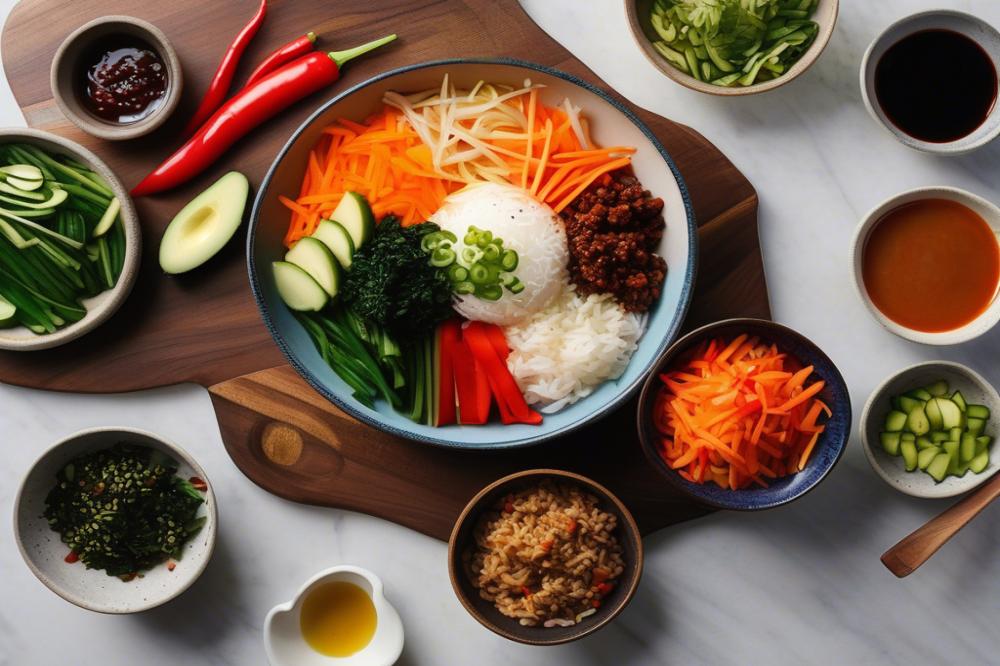
To create a delightful and flavorful bibimbap recipe, you’ll need a variety of ingredients. This classic Korean dish is as versatile as it is delicious. Below is the list of ingredients with specific quantities.
- Cooked rice: 2 cups
- Gochujang sauce: 3 tablespoons
- Assorted vegetables (such as zucchini, carrots, spinach, and mushrooms): 2 cups total
- Sesame oil: 1 tablespoon
- Soy sauce: 1 tablespoon
- Egg: 1, for topping
- Sesame seeds: 1 teaspoon
- Optional proteins (like tofu or beef, if desired)
Each ingredient contributes to a healthy meal that bursts with flavors. Let’s take a closer look at the nutritional information for these components.
Nutritional Information
Cooked rice provides roughly 200 calories per cup, with about 4 grams of protein and minimal fat. This staple is an excellent source of carbohydrates. Gochujang sauce, known for its spicy kick, has around 30 calories per tablespoon. It contains a modest amount of carbohydrates and offers some vitamins. Assorted vegetables add essential nutrients to the dish. A mix totaling 2 cups can include around 100 calories, packed with vitamins and minerals like A, C, and iron.
Sesame oil contributes about 120 calories per tablespoon, mainly from healthy fats. Soy sauce adds about 10 calories but delivers a punch of flavor. One egg, used as a topping, contains around 70 calories and offers high-quality protein, along with fats and vitamins like B12. Lastly, a teaspoon of sesame seeds adds another 15 calories, along with a bit of protein and healthy fats.
Incorporating optional proteins like tofu or beef can enhance the meal. Tofu has around 80 calories per 3-ounce serving and is a great source of plant-based protein. Beef, on the other hand, varies significantly, with roughly 250 calories for a 3-ounce portion, depending on the cut.
This dish not only embraces the essence of Korean cuisine but also caters to those looking for vegetarian dishes. It can adapt easily to different diets, making it a great option for anyone craving quick recipes or spicy Korean food. All these elements combine to create a delicious rice bowl packed with flavor and nutrition.
Cooking Instructions
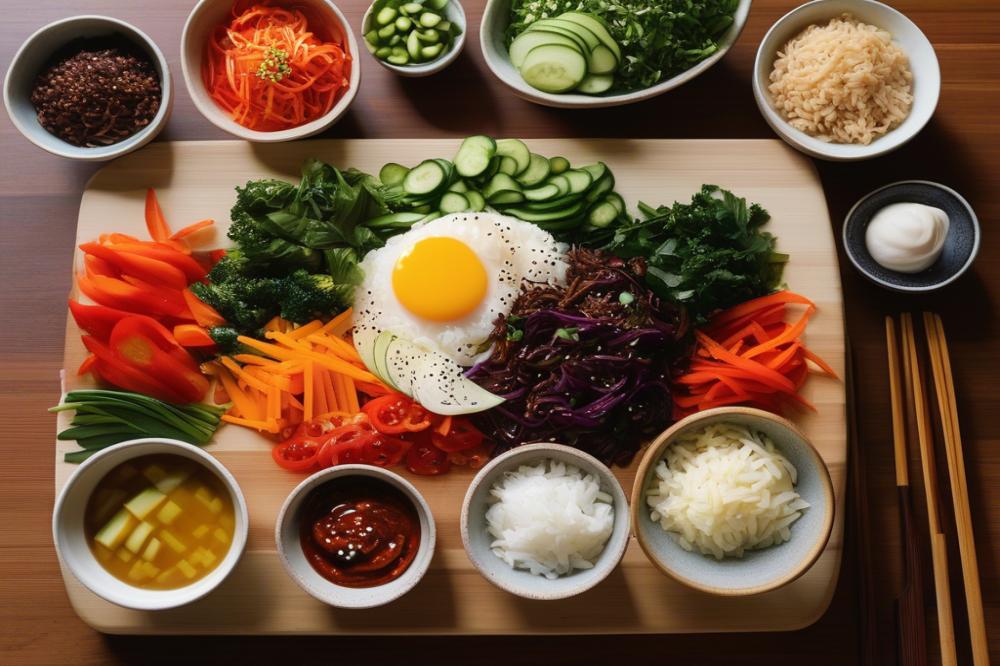
Start by preparing the rice. Use short-grain or medium-grain rice for the best texture. Rinse the rice under cold water until the water runs clear. Combine one cup of rice with one and a half cups of water in a pot. Bring it to a boil, then reduce the heat and cover it. Let it simmer for about 18 minutes or until all the water is absorbed. Once done, remove it from heat and let it sit for a few minutes, covered.
Next, focus on the vegetables. Popular choices include carrots, spinach, zucchini, and mushrooms. Slice the vegetables into thin strips for quick cooking. Heat a tablespoon of oil in a pan over medium heat. Sauté each type separately to maintain their colors and flavors. For instance, cook the carrots for about three minutes until tender. Spinach cooks quickly, so just a minute will do. Season with a pinch of salt to bring out their natural taste.
If you wish to make your own gochujang sauce, it’s quite simple! Combine three tablespoons of gochujang with a teaspoon of sugar, a teaspoon of sesame oil, and a splash of rice vinegar. Mix everything well until the ingredients are blended together. Adjust the sauce’s spice level by adding more sugar or vinegar to fit your taste.
Cooking the egg is another essential step. You can choose to fry or poach it. For a fried egg, heat a little oil in another pan and crack the egg in. Fry it sunny-side up, letting the yolk stay soft. If you prefer poached, bring water to a gentle simmer. Crack the egg in and let it cook for about three minutes. The white should hold together while the yolk remains runny.
Finally, it’s time to assemble the bibimbap bowl. Start with a scoop of the warm rice as your base. Arrange your colorful sautéed vegetables on top in an eye-catching manner. Place the fried or poached egg right in the center. Drizzle the homemade gochujang sauce over the vegetables and rice. You may also want to sprinkle sesame seeds or sliced green onions for added flavor. This rice bowl is perfect for meal prepping or a healthy dinner. Enjoy your tasty creation!
Tips for Perfecting Your Gochujang Bibimbap
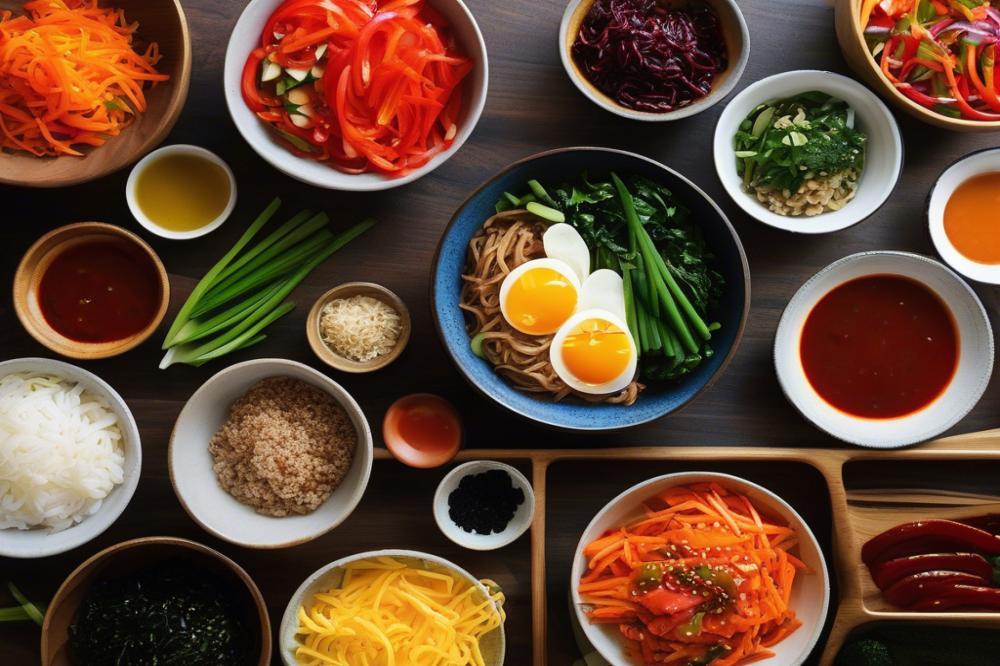
Choosing the Right Vegetables for Balance and Flavor
Selecting vegetables is crucial for a great bibimbap recipe. Think about colors and textures. Carrots add sweetness, while spinach brings a nice earthy flavor. Mushrooms provide umami, and zucchini offers a refreshing crunch. You could also consider using bean sprouts for some extra crunch and nutrients. Aim for a mix that balances taste and visual appeal.
Adjusting Spice Levels to Personal Preference
Everyone has their own heat tolerance when it comes to spicy Korean food. If you enjoy more heat, add extra gochujang sauce before serving. Alternatively, if you want milder flavors, use less sauce or mix with a bit of sesame oil. This flexibility allows you to customize each rice bowl for your liking. Always remember, you can start light and add more spice as needed.
Creative Variations
Many options exist for adding different ingredients. Consider including marinated tofu for protein or even a fried egg on top. This can elevate the dish, making it even more satisfying. Don’t hesitate to experiment with other vegetables like bell peppers or sweet potatoes. These additions can turn a classic into something special. Try various meats too, if you don’t mind straying from vegetarian dishes.
Serving Suggestions and Presentation Ideas
Presentation can make a meal more enjoyable. Arrange the vegetables in sections around the rice for a colorful display. A bright plate enhances the visual appeal, which is important in Korean cuisine. Top it off with a sprinkle of sesame seeds or chopped green onions. Serve with a side of kimchi for an extra layer of flavor. This not only complements the dish but also adds to the overall dining experience.
The Cultural Significance of Bibimbap in Korean Cuisine
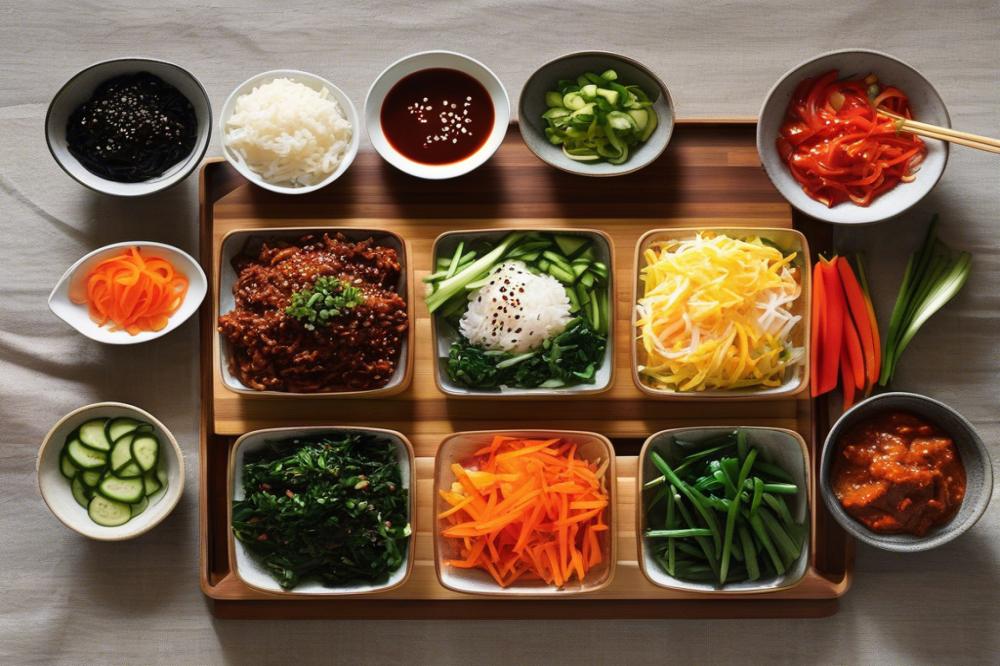
Historical Context of Bibimbap
Bibimbap has roots that stretch back many centuries in Korea. Originally, it was a farmer’s meal, enjoyed after a long day. People often combined leftover ingredients with rice to make it more filling. This dish reflects the Korean philosophy of balance and harmony, connecting various flavors and textures in one bowl. Over time, it evolved from a simple meal to a celebrated dish, loved by many.
Regional Variations and Unique Ingredients
Each region in Korea offers its twist on this rice bowl. For example, Jeonju is famous for its bibimbap, known for the use of high-quality ingredients and special gochujang sauce. Similarly, in the coastal areas, seafood might be added, giving a fresh taste. Vegetables vary depending on the season and local availability. These regional styles highlight the diverse nature of Korean cuisine and showcase the importance of ingredients.
The Role of Bibimbap in Korean Meals and Celebrations
Bibimbap serves a vital role during Korean meals. It is often considered a comfort food, enjoyed by families. Special occasions like holidays feature this dish prominently. During celebrations such as the Lunar New Year, variations filled with symbolic ingredients are prepared. People also enjoy it as a healthy meal option, as it packs plenty of nutrients from the vegetables and rice. Furthermore, it stands out as a favorite in quick recipes reflecting the essence of spicy Korean food.
Health Benefits of Gochujang Bibimbap
Gochujang Bibimbap is not just a delicious dish; it offers numerous health benefits as well. It features a variety of vegetables, which play a pivotal role in making this rice bowl a nourishing meal. Ingredients like spinach, carrots, and zucchini are rich in vitamins and minerals. Leafy greens provide fiber and can help improve digestion. Carrots boast beta-carotene, which is essential for eye health. Each vegetable contributes unique nutrients, making the bibimbap recipe diverse and nutritious.
The gochujang sauce adds more than just a kick of heat. This fermented chili paste contains beneficial ingredients like red chili peppers, glutinous rice, and fermented soybeans. These components are known for their antioxidant properties. Furthermore, they may support the immune system. The spicy Korean food creates a satisfying flavor that encourages people to eat their veggies. This combination makes a dish that is both enjoyable and good for health.
A Balanced Meal Option
When considering healthy meals, bibimbap stands out as a well-rounded option. It contains carbohydrates from rice, proteins from eggs or tofu, and a colorful assortment of vegetables. This balance makes it an excellent choice for anyone wanting a complete meal. The variety in textures and flavors can also satisfy different tastes. Each bowl can be tailored to suit personal preferences, from adding more spice to incorporating different seasonal vegetables.
The Role of Korean Spices
Korean spices bring much more than flavor; they offer benefits for a healthy diet. Ingredients like sesame oil and garlic are common in many dishes. Garlic is known for its potential to lower blood pressure and cholesterol. Sesame oil contains healthy fats, which can benefit heart health. Including these spices in everyday cooking can enhance overall well-being. Asian cooking often emphasizes the use of fresh, vibrant ingredients, promoting a lifestyle centered on wholesome eating.
Final Thoughts on Gochujang Bibimbap
Gochujang Bibimbap captivates the taste buds with its vibrant mix of flavors and colorful vegetables. This dish offers a wonderful balance of textures, from the crunch of fresh veggies to the warmth of the rice. The spicy gochujang sauce adds depth, making each bite exciting. It’s not just a meal; it’s an experience.
Trying out this bibimbap recipe at home can bring joy to your kitchen. Simple ingredients come together easily, allowing for creativity. You can choose your favorite vegetables or even add proteins like tofu or beef. Personalizing the dish makes it even more special. Gathering friends or family around the table to share this meal can create lasting memories.
The joy of preparing these flavors is matched only by sharing them with others. Cooking can be a fun activity that brings people closer. By serving Gochujang Bibimbap, you are offering a taste of Korean cuisine that many may not have tried before. Enjoy every moment of making this delightful dish. You will not only savor delicious food but also the warmth of companionship. So go ahead, roll up your sleeves, and embark on this culinary adventure.

